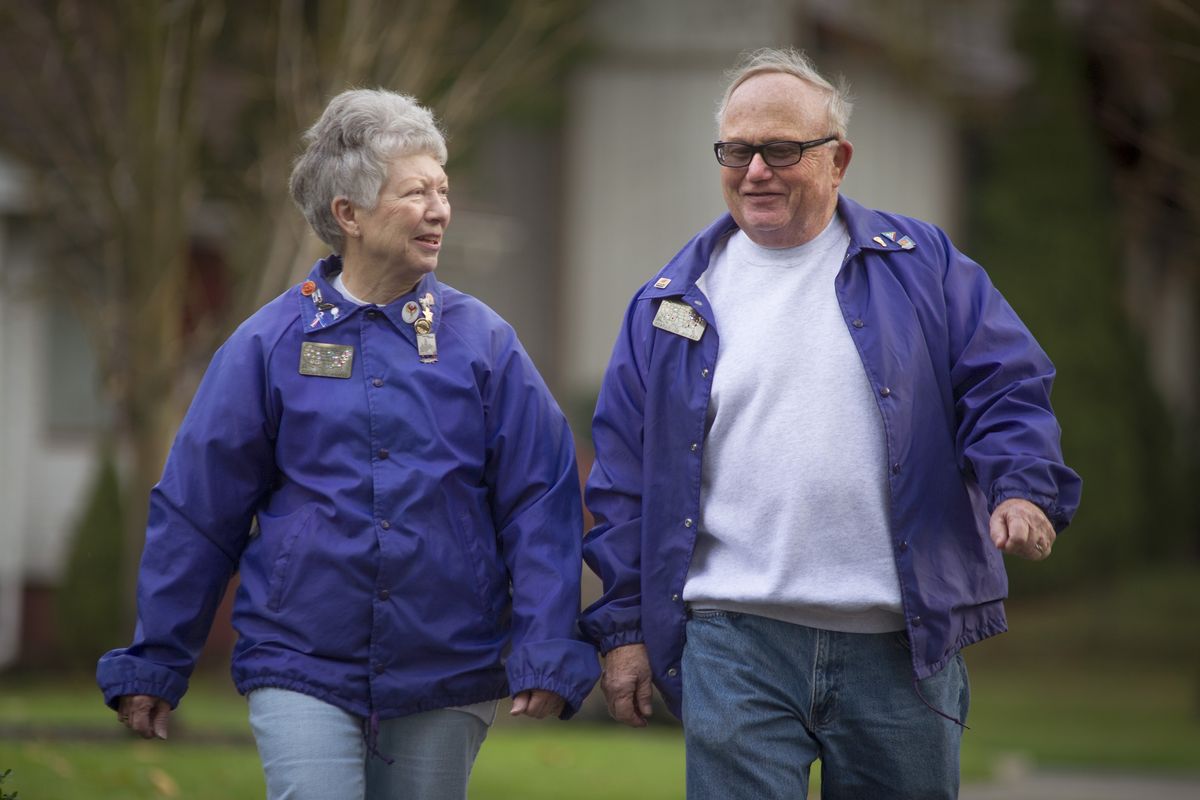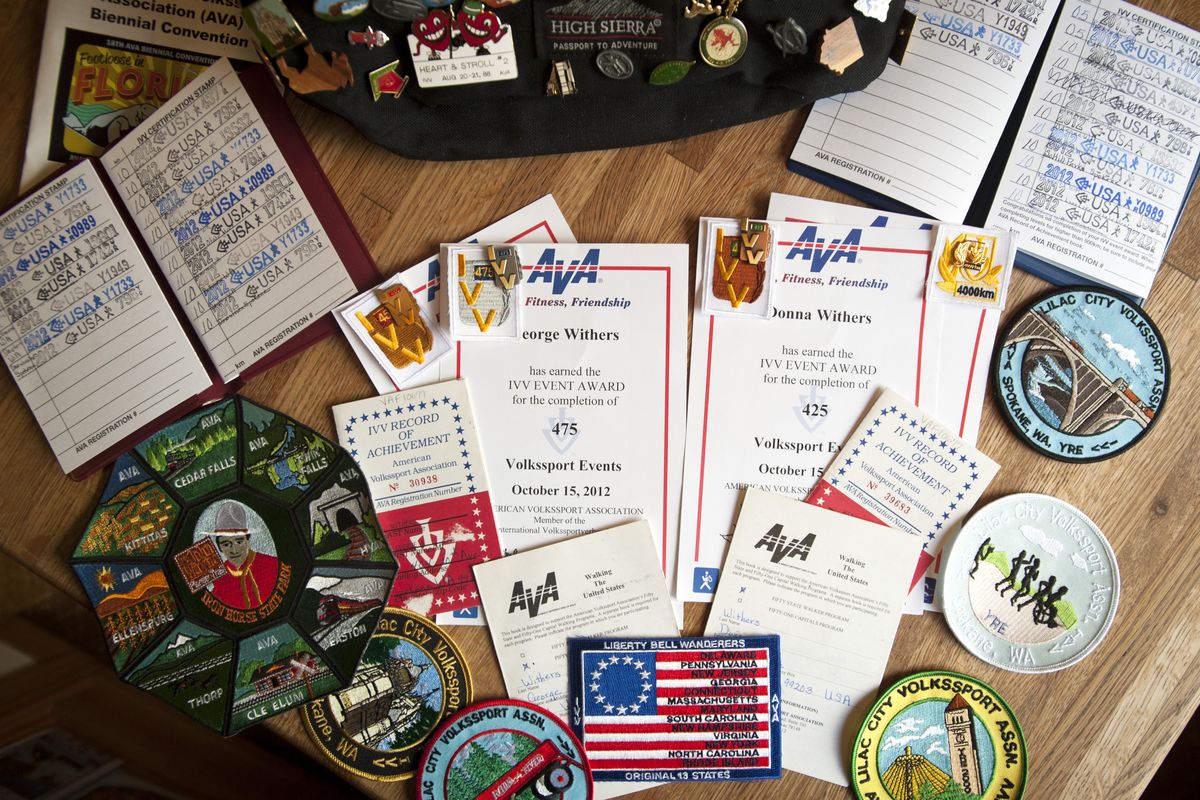The path to better health
Volkssporters’ events combine exercise, sightseeing
Donna Withers and her husband, George Withers, both 73, are active “volkssporters,” helping to organize many local walking tours. (Colin Mulvany)Buy a print of this photo
Not long after surgeons removed her kidney in March 2010, Donna Withers put on her walking shoes.
Her first few walks after surgery were just a mile long, but she worked her way up to three miles.
“By the end of August I was back to walking 10k,” said Withers, 73, of Spokane. “Not as fast as maybe I could do before, but you can’t complain when you can get back to doing it.”
As an active “volkssporter,” Withers has been regularly hitting the trail – or sidewalk – for close to 30 years. With origins in Germany, volkssport events are noncompetitive walks, hikes or occasional bike rides that combine exercise and sightseeing close to home or thousands of miles away. Add volkssport’s social aspect – volkssporters walk and talk – and it’s an activity that tends to attract retirees in search of exercise and an eye toward exploration.
For Withers, the activity “most definitely” aided her path back to health, she said. The mass on her kidney that prompted her surgery turned out to be benign.
“You can feel rather down in the dumps when something like this happens and you’re not expecting it,” she said. “But when you put yourself back out there with people that you know … they’ll slow down to keep you going and cheer you on when you get back up to where you want to be. At least for me, it was a great booster in getting me almost back to normal.”
Withers is vice president of the Lilac City Volkssport Association, which organizes dozens of walking events a year in Spokane and throughout Eastern Washington. Some are self-guided walks; group members provide directions walkers can follow at their leisure. Other walks take place at a set time and date. The group will host a Christmas lights walk on Spokane’s North Side on Dec. 15.
The goal isn’t to finish first – or even fast – but to combine fitness and a chance to see the sights.
“We’re all so used to getting in a car and zooming around, and you don’t see as much,” Withers said. “But when you’re walking, there’s so much more to see, so much more detail.”
Everyone’s a winner
Volkssport, or “people’s sport,” started in Bobingen, Germany, in 1963, according to a history by the Evergreen State Volkssport Association, which has more than 25 member clubs. The idea was to provoke more people to run by organizing timed, competitive races and awarding trophies to the winners.
“People started volkssporting in an attempt to provide something for us regular folks to do, as opposed to the serious athletes,” said Mike Nagan, 69, president of the state association.
There was a problem. The “volkslaufs” were supposed to provoke “not-so-active” people to exercise, according to the history. Competitors pushed themselves too hard, and some suffered injuries. Some died.
The events declined in popularity.
But clubs from Germany, Switzerland, Liechtenstein and Austria got together and changed the rules to promote “a new kind of wandering without classification, obligatory times and rivalry.” If you finished the first “volksmarch,” a 12-kilometer course that led to the top of a peak, within 2.5 hours, you got a medal.
Volkssport spread to the U.S., home now to about 300 clubs that organize 3,000 events, according to the American Volkssport Association.
Walking for health
Most people get involved because volkssport gives them a time and a place to get moving, Nagan said: “It just gives people a little incentive to do what they know they should do anyway.”
Lilac City club member Audrey Merrill, 76, of Spokane, said she became a volkssporter decades ago while living on an Air Force base in California. Her husband jogged, she said. She figured she ought to get some exercise, too.
“With four children and all, it did get me out of the house for a good period of time,” Merrill said.
Walking can lower “bad” cholesterol and raise “good” cholesterol levels, reduce blood pressure, manage weight, improve mood and help people stay strong and fit, according to the Mayo Clinic. And regular brisk walks can reduce the risk of heart attack by the same amount of more vigorous exercise, such as jogging, according to the clinic.
Most volkswalks are 10 kilometers – a little more than 6 miles – although many have 5-kilometer alternatives. They’re rated according to difficulty on a scale of 1 to 4. At the easy end, Nagan said, might be the flat walk on a paved trail near his home in West Seattle’s Alki neighborhood. At the difficult end, a “rugged” walk to the top of Mount St. Helens he did. “That was almost crawling,” he said.
Compared to quick dates at the gym, a volkswalk is exercise that takes awhile. That may be one reason most volkssporters are retirees, Withers said – and their ranks shrinking as the oldest among them die off and fewer people step up to replace them.
“A lot of people, when they’re doing their exercise, they want it over in 30 or 45 minutes,” Withers said. “That kind of leaves our kind of activity out for those people.”
‘A better sense of place’
The slower pace, however, allows time to look around. The routes are carefully plotted by other volkssporters, offering looks at natural scenery, historic buildings or other attractions.
“It’s slower, but you’re on the ground,” Nagan said. “You get a better sense of location, a better sense of place. You see things you’d never see using another mode of transportation.”
Nagan said he’s walked in every county in Washington and all over Canada. He recently returned from a walking trip that covered New Delhi and rural areas of India.
Withers and her husband, George Withers, also 73, have done a five-island walk in Hawaii and a 13-state fall-foliage tour in New England. Close to home, they’ve walked at Farragut State Park and Newport, in Dayton and downtown Spokane. A walk at Riverside State Park includes the Fort George Wright Cemetery atop a bluff overlooking the Spokane River, a spot she figured few Spokane residents know existed.
For Merrill, the chance to meet new people on the trail is part of the attraction.
“We walk and talk, and we’re from different parts of the city – just people who only came together because we’re walking,” Merrill said. “We’re not (together) because of a church or a business or anything like that, just strangers that came together.”

